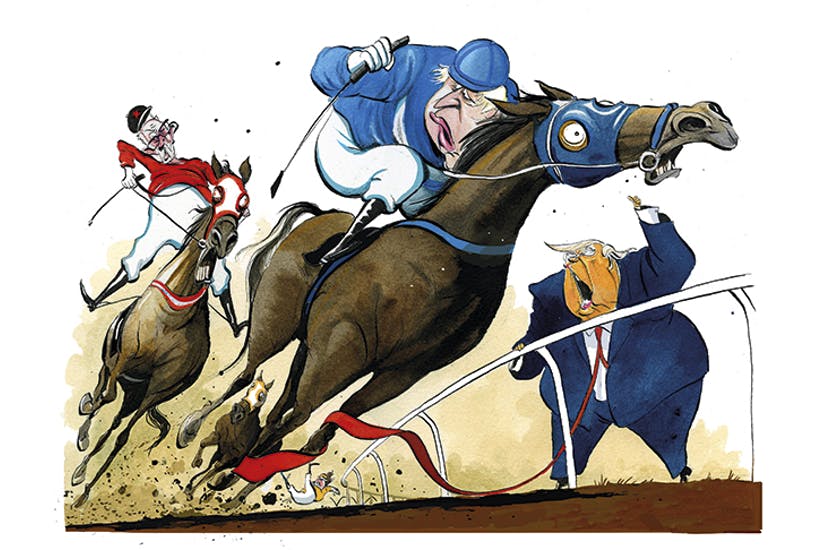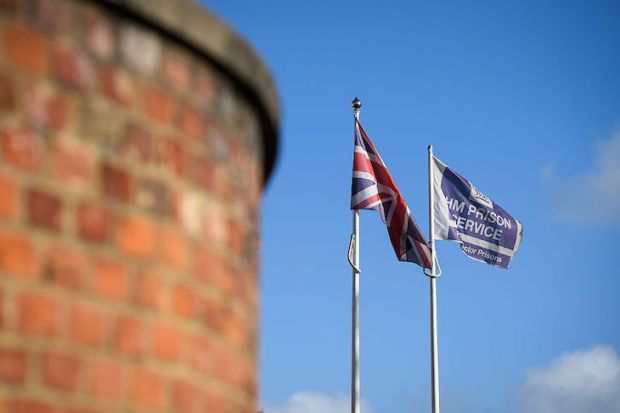It’s easy to imagine prime ministers on election night, either nervously grinning or groaning in despair when the results for Dartford are announced. In every election since 1964, the London constituency has voted for the party which went on to win nationwide. It, along with nine other constituencies (such as Watford, Reading West and Worcester) are the true bellwether seats, which have predicted the national mood since the 1980s.
This election though, it’s harder to know if these seats will accurately reflect the final election result. Boris Johnson’s Tories are hoping to flip the electoral map, abandoning their old heartlands and affluent Remainers in favour of Northern and Midland Labour strongholds which voted Leave in 2016. Last night’s YouGov MRP analysis of the polls, which suggested we could be in hung parliament territory, showed that these ‘Red Wall’ seats are no longer trinkets for the Conservatives, but essential to their success – if the Tories want a majority, they will have to make inroads in seats that have been Labour’s for decades.
So, if the electoral map has changed, what will be the bellwether seats of the 2019 election? Here are Coffee House’s pick of the seats that may give an indication of the final result on election night:
Workington
Incumbent: Labour
Majority: 3,925
Expected time to declare: 1am
Ever since the think tank Onward coined the term ‘Workington man’ to describe the kind of older, Leave voting man who might switch his vote from Labour to the Tories, this Cumbrian constituency has reluctantly become the focus of the election campaign. Workington has voted Labour for decades, but after 61 per cent of its residents backed Brexit in the 2016 referendum, it is considered exactly the kind of seat the Tories will have to win over in the North if it wants to break the ‘Red Wall’. The polls currently have Workington on a knife-edge, with the latest YouGov MRP polling analysis suggesting it currently leans Labour. If Workington stays red on election night, it seems likely that the Tories will struggle elsewhere in Labour heartlands, and will have a tough ask to scrape together a majority elsewhere.
Nuneaton
Incumbent: Conservative
Majority: 4,739
Expected time to declare: 1.30am
Everyone, from esteemed pollsters to political pundits, seems to have written off a large Labour swing or majority this election. Even so, it probably still makes sense to keep half an eye on Nuneaton on election night. The Warwickshire town has reflected the result nationwide since 1997, and makes a fair case for being a demographic mirror of the UK as a whole. If Labour do win here, it’s probably one of the first signs that the polls have got it very wrong, and we’re heading for a decent sized Labour swing.
Putney
Incumbent: Conservative
Majority: 1,554
Expected time to declare: 2am
Tactical voting by Remain parties is one of the greatest threats to the Tories’ chances this election. If Lib Dem voters across the country hold their respective noses and lend their votes to Labour in key seats, they could inflict a disproportionate amount of damage to Boris Johnson’s party. The leafy constituency of Putney, in the South West of London, will probably be a good indicator of how effective tactical voting has been this election. In 2016, 72 per cent of its residents voted to Remain; it has been held by the Tories since 2005; and is currently considered to be a tossup between the Conservatives and Labour. Should Labour succeed here on the night, it suggests that they will do similarly well in Remain-leaning seats across the country.
Plymouth Moor View
Incumbent: Conservative
Majority: 5,019
Expected time to declare: 4am
The seat of Plymouth Moor View, held by the irrepressible Conservative candidate Johnny Mercer, could be an interesting one to watch on election night. The area is a Labour / Tory marginal which voted 68 per cent to Leave in 2016. So far, the general narrative of the election campaign has been that the Labour party has lost scores of Leave voters, after it positioned itself in favour of a second referendum. But if, as in 2017, those Labour voters are ‘stickier’ than expected, and end up reverting back to their old party on the day of the poll, then you could see the party take Plymouth Moor View back from the Tories.
Bassetlaw
Incumbent: Labour
Majority: 4,852
Expected time to declare: 4am
John Mann, when he was a Labour MP, managed to take the Nottinghamshire seat of Bassetlaw with a majority of 4,852 in the 2017 general election. Since then, the MP has quit the Labour party to become the government’s anti-Semitism tsar and joined the House of Lords. Labour now face an uphill struggle to keep hold of the seat, which voted 68 per cent to Leave in 2017. Either way, Bassetlaw will be a fairly good indicator of Tory fortunes in Labour Leave seats elsewhere.
Cheltenham
Incumbent: Conservative
Majority: 2,569
Expected time to declare: 4am
It’s generally been accepted that the Lib Dems have had a pretty dire election campaign. Their pledge to revoke Article 50 has alienated all but the most ardent Remainers, while their unwise decision to have Jo Swinson fronting a presidential-style campaign has spectacularly backfired with the rest of the country. That said, it could be that the party does better than the current polls predict, as they pick up votes from disaffected Tory Remainers in the South. If that’s the case, the Cotswolds town of Cheltenham will probably be the best indicator of a Lib Dem surge. It’s a Lib Dem/Tory marginal, which has been held by the Conservative candidate, Alex Chalk, since 2015. A strong win for the Lib Dems here would indicate that this is no longer a two-horse race between Jeremy Corbyn and Boris Johnson, and the Lib Dems will make serious gains elsewhere.
Stoke-on-Trent North
Incumbent: Labour
Majority: 2,359
Expected time to declare: 5am
Stoke-on-Trent North, which makes up one third of the famed Staffordshire Potteries, has ties with the Labour party that go back decades, and it has been held by the party since the seat was formed in 1950. This year though should really be the turning point for the Tories’ fortunes in the area. In 2017 Labour’s Ruth Smeeth only hung on to the seat by her fingertips, and 72 per cent of the constituency’s voters backed Leave in 2016. Stoke-on-Trent is therefore the Conservative’s first step in scaling the Red Wall and when the result is announced at 5am, we should finally know if the Tories have succeeding in building a new electoral coalition that includes the Midlands and the North.
Gordon
Incumbent: Conservative
Majority: 2,607
Expected time to declare: 5am
It’s make or break in Scotland for the Tories this election – the party will struggle to form a majority if it fails to hang on to the 12 seats Ruth Davidson clawed away from the SNP in 2017. While the Tories have a series of slim majorities to defend north of the border, making things particularly unpredictable, the seat of Gordon should give us a reasonable idea of how they will fare in the rest of the country. The Conservatives had a 2,607 majority here in the 2017 election, and North East Scotland is not their natural stomping-ground. If they hang on to Gordon, the Tories probably will have avoided a wipeout in Scotland.
Ashfield
Incumbent: Labour
Majority: 441
Expected time to declare: 5am
Ashfield in the East Midlands sums up the Tory strategy in this election. The Conservative candidate, Lee Anderson, is a former coal miner and Labour supporter, who switched to the Tories because of Brexit and Jeremy Corbyn. He will be hoping to overturn the majority of 441 that Labour’s Gloria De Piero built in the 2017 election, and win over the region’s Leave voters (70 per cent of the region voted for Brexit). As well as being a mainstay of the ‘Red Wall’ that the Tories have to break through, Ashfield will also be a helpful indicator of the impact of the Brexit Party in Labour heartlands. The Brexit party’s decision to stand down in former Conservative seats may have helped the Tories defend their 2017 gains, but it could equally split the Leave vote in constituencies like Ashfield, and allow Labour to hang on to seats across the Midlands and North.
Dudley North
Incumbent: Labour
Majority: 22
Expected time to declare: 5am
Things will have gone badly wrong for the Conservatives if at 5am they haven’t managed to take Dudley North from Labour. Not only did they come within 22 votes in 2017, but Labour’s former candidate Ian Austin has since denounced his old party under Jeremy Corbyn, and called on his constituents to vote Tory instead. Dudley North – which voted 70 per cent to Leave in 2017 – is essentially the bare minimum the Tories should expect to take by the early hours. If they fail to win this old Labour safe seat, serious alarm bells will be going off at CCHQ.
Got something to add? Join the discussion and comment below.
Get 10 issues for just $10
Subscribe to The Spectator Australia today for the next 10 magazine issues, plus full online access, for just $10.





















Comments
Don't miss out
Join the conversation with other Spectator Australia readers. Subscribe to leave a comment.
SUBSCRIBEAlready a subscriber? Log in